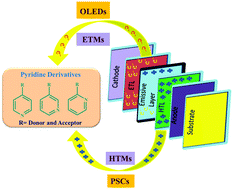Recent development of pyridine based charge transporting materials for organic light-emitting diodes and perovskite solar cells
Abstract
In recent years, donor-acceptor based pyridine derivatives have significantly been used in organic solar cells (OSCs), thermally activated delayed fluorescence (TADF), organic light emitting diodes (OLEDs), perovskite solar cells (PSCs) and many more. Pyridine derivatives are used as charge carriers i.e. hole transporting materials (HTMs) in perovskite solar cells (PSCs) to improve the power conversion efficiency and stability of photovoltaic devices due to the enhanced open circuit voltage, film uniformity and improved hydrophobicity which further increase the long term durability. Pyridine derivatives are suitable electron transporting materials (ETMs) used in organic light emitting diodes (OLEDs) to improve the current efficiency, external quantum efficiency and thermal stability of the optoelectronic devices through high triplet energy to avoid the exciton quenching, low operating voltage, and smooth film formation ability. The frontier energy levels of pyridine based ETMs are controlled by aromatic π-conjugated moieties at the ortho, meta, and para positions of the pyridine unit, which provides deep highest occupied molecular orbital (HOMO) levels to block the holes/excitons and appropriate lowest unoccupied molecular orbital (LUMO) levels for smooth electron injection. We have explained the intermolecular and intramolecular interactions in the pyridine derivatives, which facilitate charge injection and enhance the electron transporting mobility of the ETMs used in organic light emitting diodes (OLEDs). In the review, we provide a better outlook of the recent developments in the design and synthesis of various donor-acceptor based pyridine derivatives as 4-tert-butylpyridine (tBP) additive free and dopant free hole-transporting materials (HTMs). The pyridine could form a Lewis acid-base adduct in the HTM and tris(pentafluorophenyl)borane (BCF) interacted with methylammonium lead iodide (MAPbI3), resulting in the MAPbI3/HTM interface becoming more selective for holes in the perovskite solar cells (PSCs).

- This article is part of the themed collection: Showcasing recent research in materials chemistry from IIT Bombay, IIT Indore and IISc


 Please wait while we load your content...
Please wait while we load your content...